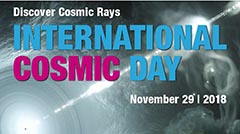Announcement oh the ICD2018
The International Cosmic Day will take place for the seventh time on November 29, 2018. Teachers and scientists at more than 60 schools, universities and research institutions in over 15 countries will guide young people from all over the world through experiments on the cosmic particles that fly through us unnoticed all the time. International research experiments, such as ATLAS in Geneva and IceCube at the South Pole, provide up-to-date data for the event. This year, for the first time, it will be possible to participate without having to take your own measurements. The web portal Cosmic@Web, specially developed by DESY for student projects, provides data from long-term experiments that can be evaluated. Another new feature is data supplied by an instrument installed on Alfred Wegener Institute’s research vessel, the Polarstern. This detector is one of the long-term experiments whose data feed the web portal Cosmic@Web.
“Events such as the International Cosmic Day are essential to our efforts to expose young people to science. Young people from all over the world can get a first-hand insight into how our research works and find out what exciting findings still await us,” explains Helmut Dosch, Chairman of the DESY Board of Directors. The research field of astroparticle physics has developed rapidly in recent years. All known cosmic messengers, from cosmic rays to gamma rays, neutrinos, and gravitational waves, have only just begun to be measured. Huge observatories are being built to detect the smallest particles that flow through the cosmos. These cosmic particles provide the necessary information to gain insight into the most energetic processes in our universe. Even if we can’t see them with our eyes, the messengers from outer space fly through our bodies all the time. When particles from the cosmos hit the Earth's atmosphere, they create a shower of thousands of new particles. Many of the new particles decay after a short time. Not so the muons. They can reach the ground to be detected and tell us more about the universe.
On International Cosmic Day, we will measure the directions of muons from cosmic rays. Do we get the same number of muons from all directions, or is there a preferred direction? The young people, researchers and teachers will discuss the measurements in their local groups and with other groups across the world via video conferences and chats, and then document their results in a joint publication. The joint work makes it clear to the young people how international cooperation works and how science functions as a connecting element across national borders, language barriers, and cultural differences. "The young people experience how new knowledge can be created together. On this day, they work as if in an international collaboration. We are particularly pleased that since this year, young people worldwide have had the opportunity to participate in research with the web portal," explains Carolin Schwerdt, coordinator of the astroparticle projects for young people at DESY and the nationwide German Network Netzwerk Teilchenwelt.
If you do not have access to measurement equipment on International Cosmic Day, you can use the web portal Cosmic@Web to evaluate data provided by a long-term experiment that was developed at DESY in Zeuthen and has been taking data since 2016. This instrument, called CosMO-mill, is structured in much the same way as the experiments that are used on site at many locations. The difficulty, however, is that large data sets have to be evaluated for long-term experiments. Since their complex data processing can no longer be carried out with conventional spreadsheet programs, we developed Cosmic@Web to perform the data analysis efficiently. A graphical user interface offers the user a selection of visual representations of the data. From this, conclusions can be drawn about the physics of the observed phenomenon. The web portal is the interface between the user, who selects the data sets, and the backend that processes these data.
This year, for the first time, anyone who is interested in getting to the bottom of the exciting questions of astroparticle physics can participate in the International Cosmic Day, regardless of whether they can carry out their own measurements of cosmic rays or whether they use the existing data sets from web portal for their evaluation. This is a further important step towards making research a tangible experience for everyone.
The International Cosmic Day is an initiative of DESY in cooperation with Netzwerk Teilchenwelt in Germany and on an international level with the International Particle Physics Outreach Group IPPOG and the Research Center Fermilab with its teacher network QuarkNet in the USA.
Further information: https://icd.desy.de





